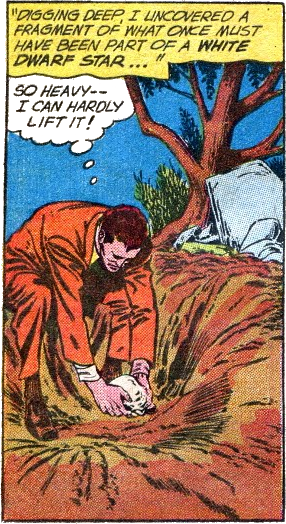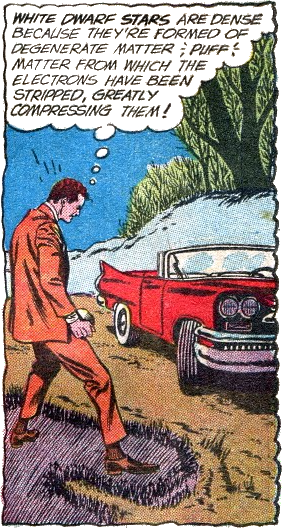Degenerate Matter
1 June 2010At Kingdom Kane (a 'blog focussed upon the art of Gil Kane), Mykal Banta has reproduced The Birth of the Atom
. a story which contains what I have long regarded as an epitomal sequence of what I call comic-book science
: 



As I noted to Mykal, a white dwarf star has a density of about 1 million grams per cc, and the meteor appears to be about 1000 cc, so the whole thing should mass at about 1 million kilograms.
It's not apparent why 1 million kilograms should stay compressed into such a small volume. In the case of a dwarf star itself, the gravitational mass of the star as a whole creätes sufficient force, but this is just a fractional piece of such a star. It ought to fly apart as a terrible burst of radiation. But let's assume that this somehow doesn't happen, that the meteor just stays together in a nifty one-liter piece.
The meteor that creäted Meteor Crater in Arizona was under 30,000 kilograms. Ray wouldn't be excavating the meteor at all; he would have been killed by the shock waves from the impact. Those who later did excavate the meteor wouldn't find it buried just a couple of feet deep.
At the surface of the Earth (which itself masses about 5.97 × 1024 kilograms), this meteor would weigh about 11 hundred tons, but Ray picks it up! He subvocalizes a few puffs, but he manages to carry the thing back to his car! Now-a-days, they don't make cars that can carry 11 hundred tons. I don't think that any grad students can lift 11 hundred tons. And, really, Ray ought to be sinking into the ground, as even if he has big feet and has both feet on the ground he is applying over 7000 kPa of pressure to the soil.
It might be suggested that the meteor, while perhaps of material that were once compressed to a density of about 1 million grams per cc, were subsequently uncompressed, and that what Palmer recovered were only, say, 100 kilograms of material. But I don't know how, then, it would be recognizable as originating from a white dwarf star. For example, the core of the sun compresses matter to a greater density than 100 grams per cc.
Fatal Escape
28 May 2010To-day, when I was starting my shower, I saw what looked like a silverfish swirling around in the water. I don't want silverfish in my apartment, but didn't see any need for the thing to die, and the water hadn't been hot enough to kill it, so I held my hand over the drain, turned-off the water, and let what was in the tub drain slowly.
Sure enough, there was a water-logged silverfish. I grabbed a clean, empty bottle in which the silverfish could be held until I finished showering and dressing, and some bathroom tissue with which to pick-up the insect, as I could not pick it up with my bare fingers without crushing it.
I made the mistake of using dry tissue, which did not mold itself around the creature, and which wicked the remaining water off it, so that the thing was able to leap free…
…into the drain.
Well, I'd tried.
And He'd Know Better if He Needed One
23 May 2010D.C. to begin using more-expensive Trojan condoms in HIV prevention programby Tim Craig of the Washington Post, 21 May 2010
[…] D.C. officials have decided to stock up on Trojan condoms, including the company's super-size Magnum variety […]
(Underscore mine.) Actually, the Magnum® variety is not super-sized. It is not much different in size from various other condoms. It is simply marketed in a manner that yields an impression of being super-sized to those who don't actually check the facts — such as journalists. An ordinary-sized Trojan condom is 52mm wide and 200mm long; the Magnum® is 54mm wide at the base, widening to 60mm at the head, and 205mm long. (The Magnum® XL differs in that it widens to 65mm at the head.)
(The Durex® Avanti™, on the other hand, has a width of 64mm along its length. It is, however, only 180mm long, which might be of concern if the condom is being used to prevent the transmission of disease and the anatomies of the sexual partners allow penetration to a greater depth.)
When the subject of condom size is raised, many women and various men with small penes make the point that condoms stretch, so that a regular-size condom can be put on a larger penis. Indeed, but elastic substances produce greater counter-force when stretched farther. The fact that someone might be able to fit a spring around his-or-her cranium (as occasionally condoms are stretched around heads for one reason or another) doesn't mean that one can comfortably wear that spring around one's penis. So larger condoms are quite appropriate for some men.
But, with the Magnum®, Trojan is selling a mere 0.08in in additional width, just 0.2in in extra length, and fantasy.
Self-Policing
20 May 2010I've written about the topic of self-policing elsewhere, earlier. But I've been thinking of writing about it here, and it arose in conversation to-day.
The term self-policing
has multiple meanings, but it usually refers not simply to individuals regulating their own behavior, nor simply to any sort of regulation of own-behavior, but to members of a group acting to regulate how other members of that group treat outsiders. When, for example, one refers to members of a profession engaging in self-policing, one is typically speaking of them taking steps to protect clients against incompetence or dishonesty.
Lots of self-policing is not recognized as such. For example, when a state goes to war, those within the nation who attempt actively to impede the war are engaged in self-policing based on notions of right-and-wrong. Those who actively seek to compel support for the war are also engaged in self-policing, albeït based upon different notions of right-and-wrong.
The American civil rights movement succeeded exactly by persuading a sufficient number of white Americans to act to regulate the behavior of other white Americans; again, it was self-policing. Whites who did no more than insist that not all whites engaged in discrimination were not truly part of the problem, but they certainly weren't part of the solution, and they ought to have been.
And likewise for those in other groups who, instead of self-policing, will merely self-righteously insist that the problematic behavior from within their group is not universal to its members. They are not truly part of the problem, but they certainly aren't part of the solution, and they ought to be. Although a people may be not only technically but meaningfully civilized without self-policing, a society or culture that lacks self-policing is none-the-less less civilized than one with self-policing. And, while we are not entitled to forceably compel other people in-or-outside of our own culture to self-police, we are entitled to demand such in non-coërcive ways, and to look with contempt upon people or peoples who do not self-police.
Everybody Draw Mohammed Day Is Here!
19 May 2010To-day, 20 May, is Everybody Draw Mohammed Day. I'm quite disappointed that its founder has retreated; I could not have withdrawn in good conscience, even though my contribution demonstrates that I am pretty poor at working in charcoal: ![[drawing of the head of a bearded man of Mediterranean stock]](http://www.oeconomist.com/blogs/daniel/wp-content/uploads/2010/05/mohammed.png)
Some people have chosen to draw caricatures, but my objective was simply to violate a grossly illegitimate prohibition. As such, I sought to draw Mohammed. If the death threats become more narrowly focussed on those who creäte caricatures, then I will creäte a caricature.
Le tut-tut
14 May 2010Somewhere in Chapter 3
14 May 2010After Adam had eaten of the fruit of the Tree, the dog did lick juice from the fruit, but from its flavor decided that the fruit was not food. And so the eyes of the dog were but little opened. The cat did merely sniff of the fruit, and then turned to other things.
The US Constitution and the National
Debt
10 May 2010
The Confederate States of America went into debt to finance their war of secession. After the war some of their creditors wanted that debt repaid. The United States, on the other hand didn't want them to recover any of their investment, for the obvious reasons. In response to the insistence that this debt not be paid, sympathizers of the Confederacy suggested that, likewise, the debt of the Union should not be paid, for the obvious reasons. Additionally, it was argued that the emancipation of slaves was a taking of private property, so that, under the Fifth Amendment, former slave-owners were owed just compensation
.
The North reminded the South who was making the rules, and included the following as section 4 of the Fourteenth Amendment:
The validity of the public debt of the United States, authorized by law, including debts incurred for payment of pensions and bounties for services in suppressing insurrection or rebellion, shall not be questioned. But neither the United States nor any State shall assume or pay any debt or obligation incurred in aid of insurrection or rebellion against the United States, or any claim for the loss or emancipation of any slave; but all such debts, obligations and claims shall be held illegal and void.
(Underscores mine.)
There's probably someone out there somewhere, even now, insisting that the debts of the Confederacy should be repaid, or that descendants of slave-holders are owed reparations, but those issues no longer have much currency, nor can they be expected to recover currency.
On the other hand, when addressing the debts of the United States, that Amendment included but did not limit itself to those debts incurred for payment of pensions and bounties for services in suppressing insurrection or rebellion
. What remain potentially relevant, then, are the underscored words:
The validity of the public debt of the United States, authorized by law, […] shall not be questioned.
The national
debts of the United States cannot Constitutionally be repudiated, without further Amendment. Under the Constitution, they have to be serviced; and, when they come due, they have to be paid.
Present levels of deficit spending are widely seen as unsustainable, and the United States Treasury has begun to pay discernible risk premia, which is to say that a significant part of the market expects that the United States might default. So one question is of how a default might be effected.
In theory, an Amendment could quickly be ratified to permit default, though a significant share of the national
debt remains domestically held, which would tend to brake the passage of such an Amendment. Of course, the beginning of the process of amendment would drastically erode confidence in the debt, so that the risk premia would grow dramatically, and the Treasury might find itself almost immediately unable to pay bills, and might remain unable to do so until the Amendment were ratified and restructuring negotiations were completed.
A more likely process would be a Declaration of Emergency, under which the Constitution were suspended
, as the federal state worked-out what it could expropriate from whom. (The Constitution makes absolutely no provisions for such emergency suspensions, but we've had a long history of our rulers claiming the power to effect them,[1] and of courts doing little to check such actions.) Again, the United States might be unable to borrow money, but the process of partial repudiation could immediately be brought forward.
Or it might be that the debt were restructured without the consent of creditors. Such a restructuring would, in fact, be a partial repudiation, but lawyers and judges have long proved adept at making distinctions where there are no differences.
[1] With one exception, during each war since the adoption of the Constitution, the President has suspended
provisions of the Constitution. That one exception was Madison, who had been the principal author both of the Constitution and of the Bill of Rights.
Good-Bye
10 May 2010Frank Frazetta
9 February 1928 – 10 May 2010
Requiescat in pace.



![[advertisement for L'homosexualite en Allemagne]](wp-content/uploads/2010/05/tutut.gif)
